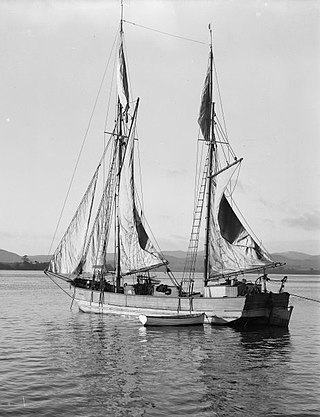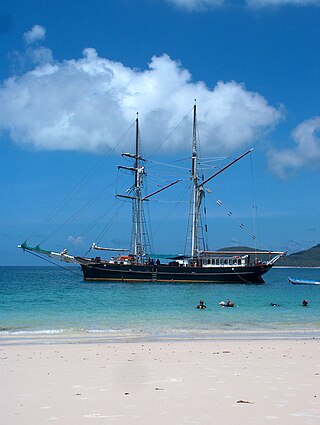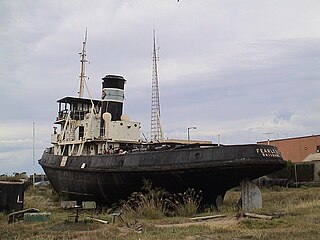
A scow is a smaller type of barge. Some scows are rigged as sailing scows. In the 19th and early 20th centuries, scows carried cargo in coastal waters and inland waterways, having an advantage for navigating shallow water or small harbours. Scows were in common use in the American Great Lakes and other parts of the U.S., Canada, southern England, and New Zealand. In modern times their main purpose is for recreation and racing; there are also garbage scows for aquatic transport of refuse.

Solway Lass is a two-masted schooner. She was built in the Netherlands in 1902 and is currently operated out of Airlie Beach, Australia as a holiday sailor in the Whitsunday Islands.

City of Adelaide is a clipper ship, built in Sunderland, England, and launched on 7 May 1864. It was built by Pile, Hay and Co. to transport passengers and goods between Britain and Australia. Between 1864 and 1887 she made 23 annual return voyages from London and Plymouth to Adelaide, South Australia and played an important part in the immigration of Australia. On the return voyages she carried passengers, wool, and copper from Adelaide and Port Augusta to London. From 1869 to 1885 she was part of Harrold Brothers' "Adelaide Line" of clippers.

The 63 ton schooner Postboy was built at Port Adelaide in 1874. The schooner was owned by Messrs. Weman and Morgan and registered at Port Adelaide. She was a regular trading vessel between Port Adelaide and the gulf ports.

HMAS Wyatt Earp was a motor vessel commissioned into the Royal Australian Navy (RAN) from 1939 to 1945 and again from 1947 to 1948.

HMCSProtector was a large flat-iron gunboat commissioned and purchased by the South Australian government in 1884, for the purpose of defending the local coastline against possible attacks in the aftermath of the 'Russian scare', of the 1870s. She arrived in Adelaide in September 1884 and served in the Boxer Rebellion, World War I and World War II.

Loch Vennachar was an iron-hulled, three-masted clipper ship that was built in Scotland in 1875 and lost with all hands off the coast of South Australia in 1905. She spent her entire career with the Glasgow Shipping Company, trading between Britain and Australia. The company was familiarly called the "Loch Line", as all of its ships were named after Scottish lochs. The ship was named after Loch Venachar, in what was then Perthshire.

Literally, the word pinisi refers to a type of rigging of Indonesian sailing vessels. A pinisi carries seven to eight sails on two masts, arranged like a gaff-ketch with what is called 'standing gaffs' — i.e., unlike most Western ships using such a rig, the two main sails are not opened by raising the spars they are attached to, but the sails are 'pulled out' like curtains along the gaffs which are fixed at around the centre of the masts.

Booya was a steel-hulled three-masted schooner with an auxiliary oil engine built in the Netherlands in 1917 and originally named De Lauwers. The schooner was renamed Argosy Lemal in 1920 and carried that name until 1949. As Argosy Lemal the ship served as one of the early United States Army communications ships from 1942–1949. In 1949, on return to civilian use, the vessel was renamed Ametco, Clair Crouch and finally Booya in 1964. Booya was last seen anchored off Fort Hill wharf in Darwin Harbour at about 8.00pm on 24 December 1974, the evening Cyclone Tracy hit Darwin. Nearly twenty-nine years later, in October 2003, she was discovered by chance in Darwin Harbour, lying on her starboard side in about 20 metres of water.

The Enterprize is a replica topsail schooner built in Melbourne, Australia. It is currently operated by a not-for-profit group for the purpose of providing the people of Melbourne with a means of experiencing nineteenth century sailing and the city's history.

Colonist was a general cargo and passenger schooner built in 1861 at Dumbarton Scotland by Denny & Rankine. It spent nearly 30 years plying the Western Pacific-based out of Sydney. It wrecked and later re-floated on the remote Elizabeth Reef 550 km from New South Wales, as well as being involved in the gold rushes. Its master was murdered before it was finally involved in a collision in Sydney Harbour, in which it was sunk.

Iserbrook was a general cargo and passenger brig built in 1853 at Hamburg (Germany) for Joh. Ces. Godeffroy & Sohn. It spent over twenty years as an immigrant and general cargo vessel, transporting passengers from Hamburg to South Africa, Australia and Chile, as well as servicing its owner's business in the Pacific. Later on, the vessel came into Australian possession and continued sailing for the Pacific trade. In 1878 it caught fire and was sunk the same year. At last, it was re-floated and used as a transport barge and hulk in Sydney until it sank again and finally was blown up.

The MV Nelcebee is an auxiliary schooner that served the South Australian coastal trade from 1883 to 1982.
Transport in South Australia is provided by a mix of road, rail, sea and air transport. The capital city of Adelaide is the centre to transport in the state. With its population of 1.4 million people, it has the majority of the state's 1.7 million inhabitants. Adelaide has the state's major airport and sea port.
HMS Gleaner was the mercantile ketch Gleaner, launched in 1802. She served the Royal Navy as the "hired ketch Gleaner" from 12 July 1808 until the Navy purchased her in 1809. Initially she served as a light vessel and survey vessel. From early 1811 to August 1811 she served in the Mediterranean, where she captured an Ottoman vessel. She then became a yard lighter and a light vessel again. Then in 1812 she was on the North American station where she participated in the capture of several merchant vessels. Next she returned to the Mediterranean where she captured a privateer. Finally, she served off the north coast of Spain where she was wrecked on 2 March 1814.

Fearless is a tugboat that beached at Cruickshank’s Corner in Port Adelaide, South Australia, at 34.84055°S 138.50259°E

Yatala was a British clipper ship that was built in England in 1865 and wrecked on the north coast of France in 1872. She spent her seven-year career with Anderson, Thomson and Co's Orient Line, sailing between London and South Australia.

The New Zealand Company was a 19th-century English company that played a key role in the colonisation of New Zealand. The company was formed to carry out the principles of systematic colonisation devised by Edward Gibbon Wakefield, who envisaged the creation of a new-model English society in the southern hemisphere. Under Wakefield's model, the colony would attract capitalists who would then have a ready supply of labour—migrant labourers who could not initially afford to be property owners, but who would have the expectation of one day buying land with their savings.
John Ralph Hansford Ward, invariably known as Hansford Ward or Captain Ward, was a ship's captain in South Australia, who figures prominently in the pre-history of the Adelaide Steamship Company. A son, also named John Ralph Hansford Ward but known as John R. H. Ward, was also a ship's captain.
Numerous vessels have borne the name Active :
















